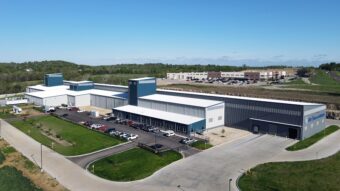David Adams knows the Indianapolis market. He’s a partner with the Real Estate and Environmental and Commercial Real Estate Lending practice groups at the Indianapolis office of law firm Krieg DeVault. In this role, he represents banks, lending institutions, developers, landlords and tenants.
Because of this, he knows how busy Indianapolis and its suburbs are today, and he understands just how high the demand is for multifamily and industrial real estate here.
Midwest Real Estate News recently spoke with Adams about the Indianapolis market, why the future seems so bright here and the development boom hitting downtown and the suburbs.
In general, how strong is the commercial real estate market in the Indianapolis area today?
David Adams: We have seen back to back to back years of consistent activity across a lot of different property types in both Indianapolis and its suburbs. That is a marked difference from the Great Recession when there wasn’t a whole lot going on here. Back then, you wondered where the next deal was coming from. Today, it feels like Indianapolis and the surrounding communities have gotten through that with flying colors.
Why has Indianapolis’ commercial real estate market been so consistent for so long?
Adams: I think some of it has to do with how Indianapolis is physically situated in the middle of the country. That certainly helps. We are in the heart of the Midwest and we are a key distribution hub coming down from the south and up into Chicago and back through the west and going east through New York. We have one of the largest FedEx hubs in the country. The highway system works well. It is situated to get things into and out of the city pretty easily. We have a location advantage that makes us an especially strong distribution market.
Most of the business leaders, developers and investors would say, too, that the labor markets continue to be competitive. Labor is less expensive here than what you might find in other similar markets. At the same time, the state and local municipalities continue to be committed to training that workforce. They sponsor initiatives to train our local workers so that they can adapt to the changes in the types of businesses that are growing in today’s economy.
The industrial market is a strong one throughout the Midwest. It seems to be particularly strong, though, in Indianapolis. Is that something you are seeing?
Adams: Everyone thinks that e-commerce is here to stay. Indianapolis’ industrial market has done really well, thanks in large part to e-commerce. Companies need to ship products quickly throughout the country, and our location in the center of the country helps with that. We all go to the same events and listen to the same speakers and experts. They continue to cite historically low vacancy rates in the industrial sector.
It wasn’t too long ago that clients were only considering build-to-suit projects or ones where there was a significant amount of space pre-leased. Now we are seeing spec product come onboard. Developers feel confident that the users are going to be there for these products. They understand that in today’s market, you need the product available so that it can be immediately occupied when companies make a decision. It can be hard for companies to plan too far ahead. They can’t always wait for the construction of a brand-new facility before they make a move. They need that space available. Today, then, it’s about having competitive product that people can move into right away.
We often hear that Indianapolis’ government officials are strongly pro-business. Is that true?
Adams: We have a good collaborative environment here. Local leaders work directly with business owners and developers. They offer solid incentive packages and tax abatement to make our area is attractive to businesses.
Another big plus for businesses considering our area is that Indianapolis is very reasonably priced. We have a very reasonable cost of living. That makes it a desirable place. We might not have mountains or oceans, but you can afford to buy a house here. It is still attractive for people to locate here and raise a family.
Another sector that’s doing well just about everywhere is multifamily. How strong is the multifamily market in Indianapolis?
Adams: When I first moved here, there weren’t many opportunities to live in downtown Indianapolis. We settled in on the north side of the area. Very quickly after that, I saw downtown from a multifamily standpoint start to blow up. It almost seemed as if it happened overnight. Today, those options that first came online are almost outdated. The type of product coming online now is more expensive, comes with more bells and whistles. That does pose a challenge for the owners of some of the older apartment developments in downtown. If they want to raise their rents, they have to compete with the new construction.
Is there a strong demand for downtown living? Do people want to live in multifamily units in the urban core of the city?
Adams: There are younger professionals here who start out wanting to live downtown. Eventually, that kind of wears off as they get older and start having kids. But it is cool to live downtown. I’ve worked in downtown Indianapolis for well over a decade. It is impressive how much there is to do here. The amount of things going on in downtown in terms of new developments and mixed-use projects is impressive. They are keeping up the interest factor in the center of the city.
There is plenty to like about the suburbs here, too. I’ve always lived in or near the suburbs. There is still that convenience factor with living in the suburbs. The quality of the suburban schools is high. Eventually, people think about moving to the suburbs. I don’t think that’s much difference than it is any other city.
Are there any new developments hitting the Indianapolis area that are particularly exciting?
Adams: There is the expansion of the Indiana Convention Center in the heart of downtown. That is a major attraction for our city and a draw for conventions. The Bottleworks District project is another big project. This is a mixed-use project in downtown that will bring hotels, restaurants, a rooftop bar and other retail. That development is in process now. It’s a very interesting concept that will change the skyline of the city.
Then there’s the 16 Tech Innovation District that will also be located in downtown Indianapolis. This will be a hub for tech companies, life-sciences companies and engineering companies to come together and work together. That project involves some of the city’s biggest players when it comes to companies and groups that own downtown real estate. It’s a very exciting project.
As far as the future goes, the city is looking at ways to better use the White River that runs through the middle of downtown. Right now it’s a fun place to visit. You can take a paddleboat ride on the river, for instance. But the city is looking for a new vision for that area as it winds its way through downtown. That is a project that won’t pop up in 2020, but over time could be transformative for the city.
There is plenty of commercial real estate activity in the Indianapolis suburbs, too, right?
Adams: Definitely. Just look at the suburbs of Fishers and Carmel. There is a lot more to do there today than there was when I first moved into the area. There are so many more restaurants and entertainment options. Those suburbs are a popular choice among people might not be fully retired but who have seen their children move out. They want to sell their bigger house in the planned subdivision. They’re tired of mowing lawns and want to buy a zero-maintenance facility or condo. Now those options are all over, including in the nearby suburbs. The new product coming online is especially nice. It’s very well done. It fits and makes hanging out in those suburbs a fun time.
To sum it all up? There are a lot of good things happening in Indianapolis and its suburban markets. It’s a fun place to live, work and play.



